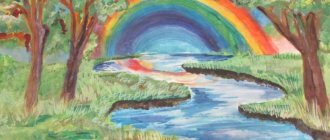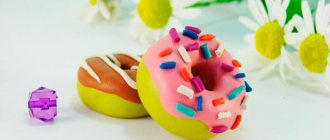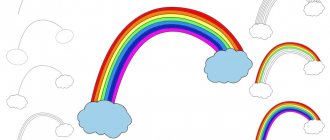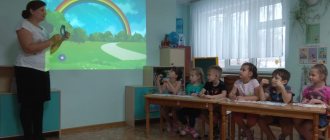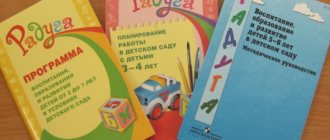What is a rainbow
A rainbow is an optical phenomenon caused by the interaction of sunlight and water droplets in the atmosphere. It is a luminous multi-colored arc.
It can be seen at high air humidity, usually immediately after rain or during it, provided that the Sun freely penetrates through the clouds and is behind the observer.
History of the study
People have long been interested in the question of why rainbows appear. The mythology of many peoples attributes sacred properties to the phenomenon.
The first attempts to explain the phenomenon from the point of view of physics were made by ancient Greek philosophers.
At the turn of the 13th–14th centuries, theologian Theodoric from the German city of Freiberg conducted experiments using glass beads filled with water as models. This method became widespread in the future.
At the beginning of the 17th century, the Croatian archbishop and theologian Mark Anthony de Dominis gave a description of the rainbow as a physical phenomenon in his work. After conducting a series of experiments with glass balls, he also concluded that the cause of the phenomenon is the refraction and reflection of light in drops of moisture.
In the 17th century, Rene Descartes, through research, established the angle of refraction of rays in a drop relative to their original direction.
Isaac Newton, having carried out optical experiments with a prism, developed the theories of his predecessors.
He identified seven primary colors, from red to purple. These are the extreme boundaries of the spectrum visible to the human eye; between them, in descending wavelength, are orange, yellow, green, cyan and indigo. The first letters of the famous phrase help to remember the order of colors: “Every hunter wants to know where the pheasant sits.”
Progress of the experiment: For the experiment we will need:
triangular transparent prism.
I took the prism in my hands and brought it to the window, the sun's rays began to pass through it, thanks to which a rainbow appeared .
Thanks to these experiments, we can conclude that our hypothesis was confirmed. Rainbow can be obtained at home.
Conclusion: the sun's rays, passing through a prism (as in the case of water, are refracted, that is, decomposed into their component parts - seven colors of the rainbow .
Experiment IV
How it appears
The reasons for the appearance of a rainbow lie in the heterogeneous nature of light. The white light we see consists of different wavelengths, which are perceived by the eye as different colors. Under certain conditions, the luminous flux is decomposed into components, resulting in a multi-colored arc.
Its formation is associated with two optical phenomena:
- diffraction - deviation of a light beam from its original direction when passing into a medium with a different density;
- dispersion - the decomposition of light into parts into a spectrum - due to the different angle of deflection of light waves of different lengths.
A ray of the Sun, colliding with a raindrop, changes its trajectory. Some of the light is reflected back, the rest of the light passes inside the drop, at an angle to the original beam. In this case, the red components of the visible spectrum, which have the maximum wavelength, deviate the weakest. And the largest angle of refraction is obtained for short-length waves - violet. Having reached the inner surface of the drop, the light is reflected from it and comes back out.
Thus, reflecting from the inner and outer surfaces of the drop, the beam is refracted and returns back at an angle relative to the original movement. As a result of these refractions, the angle between the extreme boundaries of the spectrum increases as much as possible, and the light returns to the observer in the form of a multi-colored stripe. This is called a primary rainbow, and the red color is located on the outer side of its arc, and the violet color is located below.
Progress of the experiment: For the experiment we will need:
Basin with water;
A sheet of white paper;
Flashlight, mirror.
We pour water into the basin and lower the mirror to the bottom. I turn on the flashlight and direct its light at the mirror. to “catch” the reflected beam
on a sheet of paper.
When a ray of light is refracted, a colored rainbow appears .
Conclusion: A ray of light consists of several colors; when it passes through water, it is decomposed into its component parts - seven colors of the rainbow .
3.2 Experiment II
Types of rainbow
Scientists distinguish different types of rainbows depending on the size of the drops, the intensity of light and the height of the Sun above the surface of the earth.
Sometimes you can see a second rainbow, less bright, around the first:
This occurs when the sun's rays are reflected inside the droplet twice before reaching the surface. The intensity of the light flux weakens, and the multi-colored strip appears “inverted” - the purple color appears at the top. As a result, a double rainbow appears in the sky. The celestial sector between two arcs usually has a darker hue than outside them. This area is called the Alexander Stripe, named after the Ancient Greek philosopher Alexander of Aphrodisias, who first described this effect in the 2nd century AD. e.
A triple rainbow is much less common in nature:
This is possible when the rays are reflected three times inside the drops. In this case, a third-order arc is formed, weaker than the previous two.
The sun's ray passing through large drops is weakened and creates a more diffuse spectrum. The color and brightness of the Sun changes at dawn and dusk. Sunset light travels the maximum distance to the observer's eyes, which is accessible to the long-wavelength part of the spectrum. Therefore, a red rainbow is found - with a predominance of red and orange stripes:
And if rain, rainbows and the Sun are a familiar combination observed most often, then in the absence of the Sun or rain, an atmospheric phenomenon can take on the most unusual forms.
Unusual species
Unusual and rare types of rainbows include:
- lunar;
- foggy;
- fiery.
A lunar rainbow, otherwise called a night rainbow, is much less common in nature than the usual daytime one. It occurs during the full phase of the moon in moist air. The Moon should be in a clear sky less than 42° above the horizon, and the observer should be between the Moon and the rain. Similar phenomena are known over waterfalls:
The human eye's color-detecting receptors are inactive in low light. Therefore, a night rainbow is perceived by vision as white, in contrast to the colorful daytime one. However, you can see the entire spectrum in a long exposure photo.
For a fog rainbow instead of rain and sun, a combination of fog with sunlight or moonlight is required. Since the drops of moisture in this case are very small (their radius is no more than 0.05 mm), the light in them cannot always be scattered in the form of a spectrum. This phenomenon looks like a halo of white color, which is why the phenomenon is sometimes called a white rainbow. In this case, the outer contours of the arc can be painted purple and orange:
One of the rarest weather phenomena is a fire rainbow . It looks like a horizontal arc against the background of light cirrus clouds. That is why it is also called a rainbow with clouds. Thanks to the huge radius, the arc line appears straight, extending parallel to the horizon for hundreds of kilometers:
For its appearance, three factors are necessary:
- cirrus clouds in the sky;
- flat hexagonal ice crystals arranged horizontally in clouds;
- the height of the Sun is at least 58° above the horizon.
The latter condition makes it impossible to observe this phenomenon from the earth's surface at latitudes below 55°, where the Sun does not rise so high. The situation can be corrected by climbing a high mountain.
The ice crystals should lie horizontally in the air, which is quite rare. The sun's rays penetrate through the side walls of the crystals and, being refracted, exit through the lower horizontal face. Clouds in the rays of the spectrum flash with rainbow light.
A fire rainbow is considered a type of halo.
Similar phenomena
At low air temperatures, you can see similar atmospheric phenomena:
- halo;
- inverted rainbow;
- ring rainbow.
In frosty winter, a luminous halo sometimes appears around the Sun and Moon. This effect is called a halo. It occurs near strong light sources (sometimes around street lights) and is caused by light passing through ice crystals in the lower atmosphere. The type of this phenomenon depends on the shape of the crystals and their location. Sometimes light, when refracted, is decomposed into a spectrum, and then the halo becomes like an annular rainbow:
An inverted rainbow appears in high cirrus clouds made of ice crystals when the Sun shines down on them. A downward curved arc is formed, where the lower edge is red and the upper edge is purple:
Interesting Facts
- The perception of the spectrum differs among different peoples. According to Newton's classification, blue and dark blue are replaced by blue and its darker shade - indigo. Modern Englishmen distinguish 6, not 7, primary colors: they do not divide blue into dark or light shades. And in the Japanese tradition, green is present only as a shade of blue.
- A third-order (triple) rainbow is far from the limit. The human eye simply does not perceive multiple, but weaker reflections of spectra. In laboratory conditions, using a laser setup, researchers obtained a rainbow of order two hundred.
- Typically perceived as an arc, the shape of a rainbow can be circular when viewed from a great height, such as from an airplane:
A circular rainbow results from the spherical shape of the drops. The reflected light forms a circle, the center of which is in line with the observer's eye. Therefore, a person standing on the ground cannot see the lower half of the arc.
A rainbow is just an optical effect, explained by science. It is not located in a specific place and, like the horizon line, cannot be approached. What each of us sees depends on the place of observation and our position relative to the Sun or other light source.
What time of year does a rainbow occur? Almost any time. It's just that in winter the moisture is replaced by ice crystals. Therefore, you can always observe this miracle of nature when there is a strong light source and weather conditions for its transformation into a spectrum.
Research project "Miracle Rainbow"
I learned that rainbows can be seen near waterfalls and fountains. When watering plants in the garden on a bright sunny day, you can also see a small rainbow in the splashes of water.
Conclusion:
A rainbow can be seen at almost any time of the day, even at night and in the winter cold.
How to make a rainbow at home?
You can paint a rainbow with watercolors by mixing colors.
You can make a rainbow from plasticine.
You can cut a rainbow out of paper.
To obtain a rainbow at home, we conducted several experiments.
Experiment No. 1.
Goal: get a rainbow at home using a mirror and a flashlight.
Equipment: transparent jar filled with water, mirror, light source - flashlight.
Description of the experiment:
we took a rectangular tray, filled it with water, and lowered the mirror at an angle. Then they directed the light of the flashlight onto the part of the mirror immersed in water. When we placed white cardboard in front of a mirror to catch the reflected rays, we saw on the cardboard a reflection of all the colors of the rainbow.
Experiment No. 2.
Goal: getting a rainbow at home using a ring and foam.
Equipment: ring, transparent jar, water and foam
Description of the experiment:
We placed a wire ring in a jar of soapy water. After keeping it in the jar for a while, we carefully took it out - a film had formed inside the ring. Looking at the back of the film under bright light, we saw a rainbow.
Experiment No. 3.
Goal: getting a rainbow at home using a CD.
Equipment: CD, light source - sunbeam.
Description of the experiment:
A computer disk caught a ray of sunlight and directed it to the wall and ceiling of the room. It turned out to be a rainbow.
Experiment No. 4.
Goal: make a rainbow at home using soap bubbles.
Equipment: soap bubbles, light source - sun rays.
Description of the experiment:
standing in front of the window in front of the bright rays of the sun, I blew soap bubbles. On soap film you can see stripes of colors like a rainbow.
Conclusion
: experiments have proven that you can actually make a rainbow yourself at home, even with the help of artificial light.
All the hypotheses put forward were confirmed.
Now I know that rainbows can be seen not only during the day in the summer, but also in winter, and even at night. I can make rainbows at home and I can teach it to others. The implementation of this project allowed me to develop my skills in working with additional literature, the ability to conduct experiments, analyze the results obtained, and justify the results of research. While working on the project, I learned about the natural phenomenon of the rainbow: how a rainbow appears and why it is multi-colored, I determined what the connection is between rain, sun and the appearance of a rainbow, I learned that a rainbow can be one arc, or it can be double or even triple. There is a night rainbow (lunar) and a winter one, but it is very rare and not as colorful as the summer one. From the history of the study of rainbows, I found out that many tried to explain the nature of this phenomenon, but Isaac Newton fully revealed this phenomenon. I have experimentally proven that the rainbow effect can be achieved at home and at any time of the year you can admire this beautiful natural phenomenon, which still holds many mysteries.
